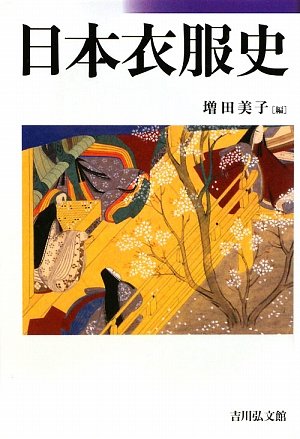17 0 0 0 OA 平安時代の喪服 : 諒闇装束を中心に
- 著者
- 増田 美子
- 出版者
- 社団法人日本家政学会
- 雑誌
- 日本家政学会誌 (ISSN:09135227)
- 巻号頁・発行日
- vol.52, no.10, pp.973-982, 2001-10-15
A certain style of mourning dress was established in the first part of the Heian period, and while almost all of the basic styles. Continued to be worn in later years, the more formal style did not appear until the latter part of the period. The formal style was called Sokutai and the informal one was known as Noushi, the same as those for the Kichibuku (normal dress), while the color itself played a key role. In the case of the Ryoan Shozoku, dressing in a blackish Tsurubami (dark brown) was normal, and Ihou (outer garments designed for each job ranking) was worn for service in the Imperial Palace. For public funeral occasions, mourning dress other than the Ryoan were Mumon Kan (plain cap without any pattern) and Nibiiro Hou (dark grey outer garments), Mumon Kan and Mumon Hou (outer garments without any pattern), and Aya Kan (cap with a pattern) and Aya Hou (outer garments with patterns) in descending order of relationship intimacy. The colors of Sitagasane (underwear) and Hakama (pants) were Nibiiro, Ao Nibiiro (bluish dark grey), Ao Kuchibairo (bluish brown) Ki Kuchibairo (yellowish brown) in descending order of the intimacy of relationship. Each person selected a combination of the style of the costume and the color from among those mentioned above, based on his or her own state of mind at each occasion. After the 49th day from the passing, which came to represent the end of one of the mourning periods, the color of the mourning dresses were gradually changed to lighter ones. Private mourning dress was also worn in accordance with public dress in principle, and females also changed their Kichibuku to those of dark grey colors.
15 0 0 0 OA 平安時代の葬送装束 : 素服を中心に
- 著者
- 増田 美子
- 出版者
- 社団法人日本家政学会
- 雑誌
- 日本家政学会誌 (ISSN:09135227)
- 巻号頁・発行日
- vol.51, no.4, pp.295-302, 2000-04-15
- 被引用文献数
- 1
It could be said that no study of funeral costume itself in the Heian period has been made so far, while studies of funeral ceremonies during that time have been done to a certain extent. This paper is presented in order to reveal the real picture of funeral costume in the Heian period by focusing on the Sofuku(the most important mourning dress worn by the people for expressing their deep sorrow and condolence on a apecific day chosen after the passing away of a person). In the early years of the Heian period, there was no specific funeral costume. Standard and consolidated funeral costume started to emerge show in the middle or later part of the Heian period. The Sofuku(even for the emperor and his male subjects)was standardized in the middle of the Heian period. All were made of Nibiiro(dark grey color)hemp cloth and were of Houeki design(the armpits are sewn up). Near the end of the Heian period, the color of the Sofuku was changed to black and the Houeki design was changed to Ketteki style(with unsewn open armpits), while the hemp cloth itself remained unchanged.
8 0 0 0 和様の成立過程 : 唐衣裳装束を中心に
- 著者
- 増田 美子
- 出版者
- 国際服飾学会
- 雑誌
- 国際服飾学会誌 = Journal of the International Association of Costume (ISSN:09176551)
- 巻号頁・発行日
- no.28, pp.4-20, 2005-11-30
2 0 0 0 OA 平安時代の喪服
- 著者
- 増田 美子
- 出版者
- The Japan Society of Home Economics
- 雑誌
- 日本家政学会誌 (ISSN:09135227)
- 巻号頁・発行日
- vol.52, no.10, pp.973-982, 2001-10-15 (Released:2010-03-10)
- 参考文献数
- 12
A certain style of mourning dress was established in the first part of the Heian period, and while almost all of the basic styles. Continued to be worn in later years, the more formal style did not appear until the latter part of the period. The formal style was called Sokutai and the informal one was known as Noushi, the same as those for the Kichibuku (normal dress), while the color itself played a key role.In the case of the Ryoan Shozoku, dressing in a blackish Tsurubami (dark brown) was normal, and Ihou (outer garments designed for each job ranking) was worn for service in the Imperial Palace.For public funeral occasions, mourning dress other than the Ryoan were Mumon Kan (plain cap without any pattern) and Nibiiro Hou (dark grey outer garments), Mumon Kan and Mumon Hou (outer garments without any pattern), and Aya Kan (cap with a pattern) and Aya Hou (outer garments with patterns) in descending order of relationship intimacy. The colors of Sitagasane (underwear) and Hakama (pants) were Nibiiro, Ao Nibiiro (bluish dark grey), Ao Kuchibairo (bluish brown) Ki Kuchibairo (yellowish brown) in descending order of the intimacy of relationship. Each person selected a combination of the style of the costume and the color from among those mentioned above, based on his or her own state of mind at each occasion. After the 49th day from the passing, which came to represent the end of one of the mourning periods, the color of the mourning dresses were gradually changed to lighter ones. Private mourning dress was also worn in accordance with public dress in principle, and females also changed their Kichibuku to those of dark grey colors.
1 0 0 0 OA 中世の葬儀と喪服 : 黒から白への回帰
- 著者
- 増田 美子
- 雑誌
- 学習院女子短期大学紀要 (ISSN:02863928)
- 巻号頁・発行日
- no.30, pp.11-34, 1992-12-25
1 0 0 0 IR 中世の葬儀と喪服 : 黒から白への回帰
- 著者
- 増田 美子
- 出版者
- 学習院女子大学
- 雑誌
- 学習院女子短期大学紀要 (ISSN:02863928)
- 巻号頁・発行日
- vol.30, pp.逆丁11-34, 1992


